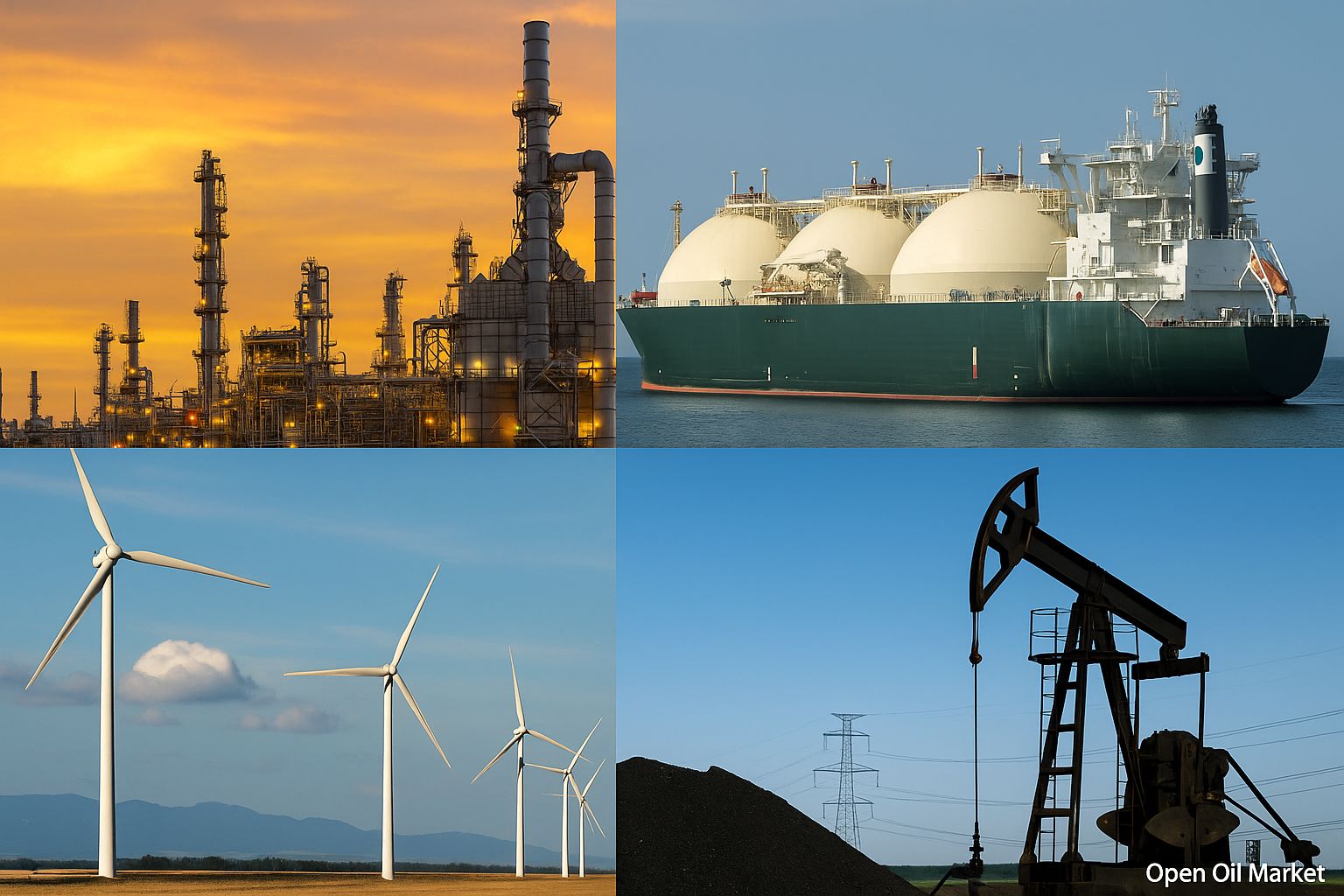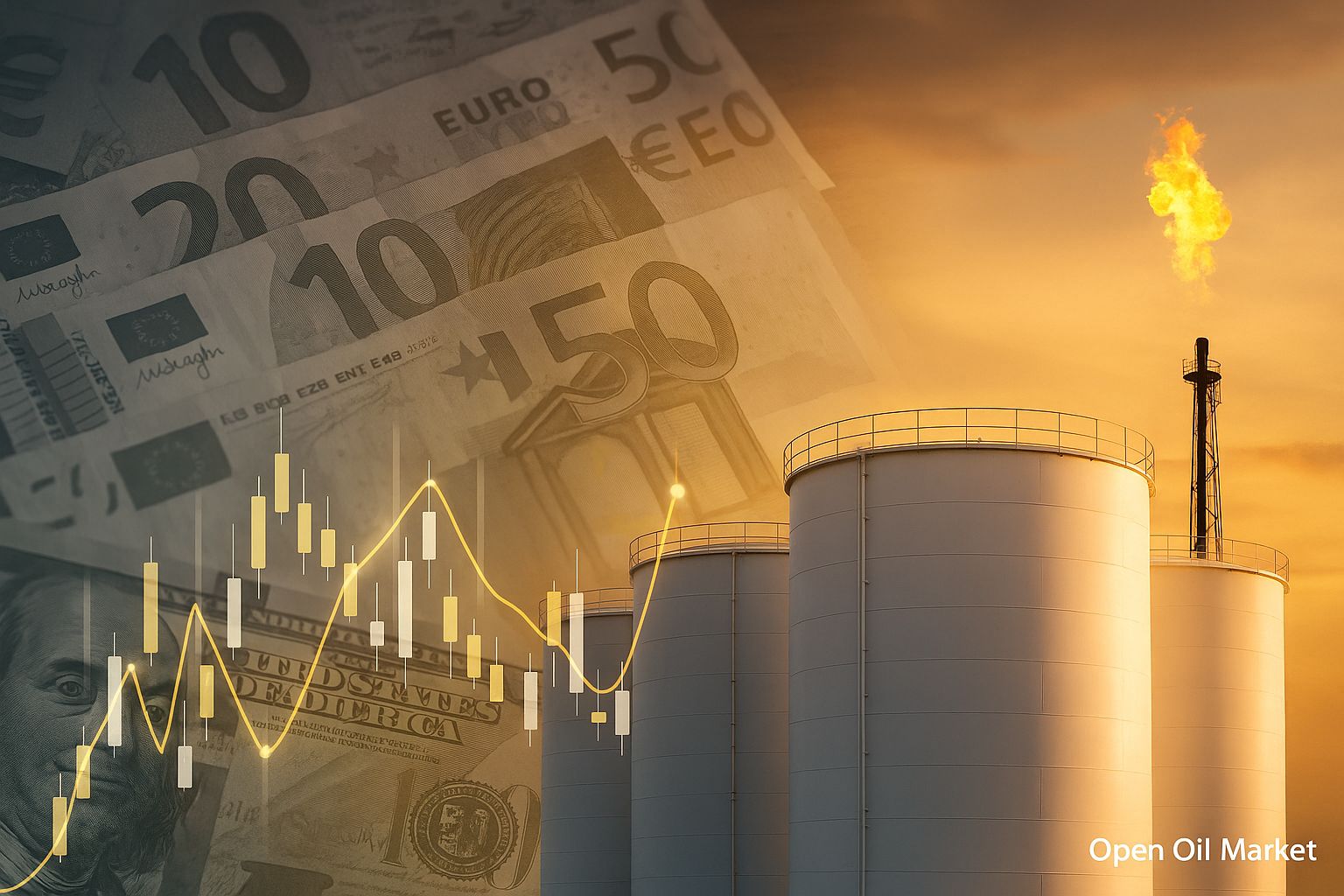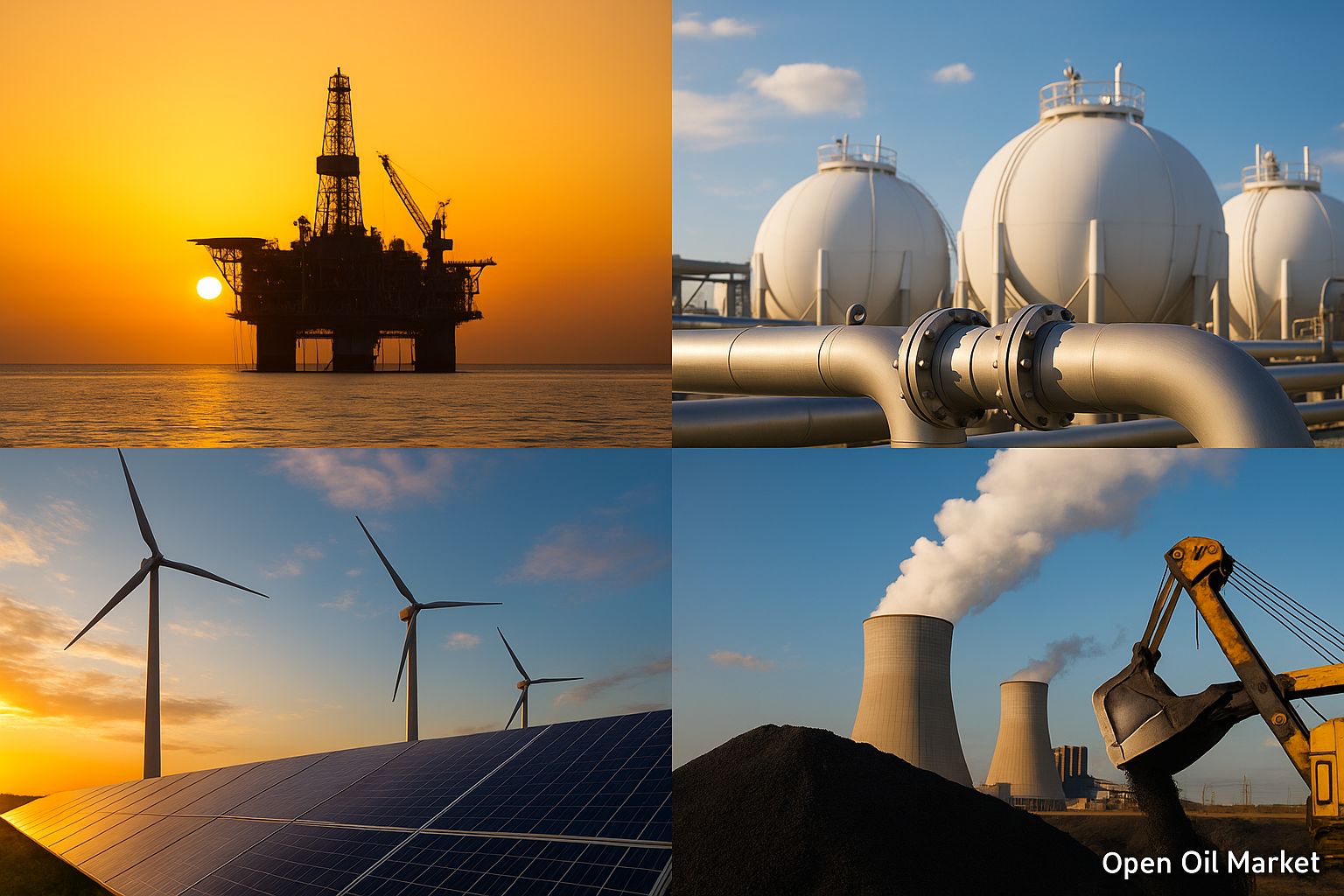
Current Energy Sector News as of October 21, 2025: Brent Oil Prices Fall Below $60, Fuel Market Stabilization in Russia, Record Gas Reserves, and Increased Investments in Renewable Energy.
As of October 21, 2025, the global fuel and energy sector exhibits a combination of fierce geopolitical confrontation and relative stability in commodity markets. The sanctions confrontation between Russia and the West remains unyielding: the UK has imposed new restrictions on major Russian oil and gas companies, and the European Union has approved a phased ban on the import of Russian gas starting in 2026. An unexpected factor has emerged in the position of India: under pressure from its partners, New Delhi has signaled its willingness to gradually decrease purchases of Russian oil—a move that could redistribute global oil flows.
Meanwhile, commodity markets demonstrate moderately calm dynamics. Oil prices are holding around multi-month lows due to expected supply surplus by year's end: Brent has dropped below $60 per barrel, while WTI is trading around $56–58. Oil quotes are approximately 10% lower than a month ago. The gas market enters winter with record fuel reserves in Europe, providing a comfortable backdrop for consumers (unless extreme cold disrupts the situation). The global energy transition continues at an accelerated pace: investments in renewable energy are hitting records, although traditional resources (oil, gas, coal) still underpin energy supply.
In Russia, emergency measures to stabilize the internal fuel market are yielding results: the fuel shortage is gradually being eliminated, wholesale prices have retreated from their peak levels, although the situation in remote regions still requires attention. At the "Russian Energy Week 2025" forum (Moscow, October 15–17), one of the main topics was ensuring the internal market for energy resources and export reorientation under sanctions. Below is an overview of the current events and trends in the oil, gas, electricity, coal, and renewable segments of the energy sector as of today.
Oil Market: Sanction Pressure and Price Minimum
Global oil prices remain at their lowest levels since early summer. Brent has fallen below $60 per barrel, while WTI hovers around $56–58—approximately 10% cheaper than a month ago. The market has once again turned downward following a brief rally in September: supply is expected to exceed demand in the fourth quarter. On the other hand, persistent geopolitical tensions prevent prices from dropping significantly, maintaining a small risk premium.
- Production is Growing, Demand Slows. OPEC+ and other producers are ramping up oil production while global demand growth is slowing down. The alliance is increasing quotas starting in November (~+130,000 barrels/day), and the US and Brazil are approaching record production levels. The International Energy Agency has lowered its forecast for oil consumption growth in 2025 to ~+0.7 million barrels/day (compared to >+2 million in 2023). The surplus supply and rising inventories continue to pressure prices.
- Sanctions and New Risks. Intensified sanctions against the Russian Federation maintain uncertainty in the market: discussions are underway regarding a complete embargo on Russian oil and suppressing "shadow" exports. At the same time, India—a key buyer—may reduce imports of Russian oil under Western pressure. The loss of the Indian market would intensify pressure on Russia's exports, but global supplies are likely to be reshuffled from other regions. Thus, ~$60 per barrel serves as a "floor" for Brent: the surplus prevents prices from rising, while geopolitical risks prevent them from falling much lower.
The oil market balances between fundamental and political factors. Surplus supply keeps prices low, yet the sanctions standoff and potential market rearrangements (such as the exit of Indian buyers) prevent prices from plunging too deep. Expectations for the upcoming months center on maintaining relatively low oil prices.
Natural Gas: Record Reserves and Eastern Pivot
The gas market is entering winter in a favorable state. European underground gas storage is over 95% full (5–7% higher than a year ago)—this has stabilized prices in the EU at around ~€30–35 per MWh. The risk of a repeat of last year’s gas crisis has significantly diminished, although much will depend on the upcoming winter and uninterrupted LNG supply.
- Europe is Ready for Winter. Record gas reserves create a robust buffer against cold weather, and demand in the EU remains restrained due to a weak economy and high renewable energy generation. Even during an extreme cold snap, a significant portion of demand can be met from storage, reducing the likelihood of shortages.
- Export to the East. Russia is redirecting gas flows to Asia after sharply reducing exports to Europe. Deliveries via the "Power of Siberia" pipeline to China have reached record volumes (~22 billion cubic meters/year), and the "Power of Siberia 2" project is being prepared to partially replace the lost European market. Simultaneously, Europe has increased LNG purchases from other suppliers to compensate for the cessation of imports from Russia. Global gas flows have already realigned: the EU is effectively managing without Russian gas, while Russia strengthens its position in Asian markets. For now, a combination of moderate demand and high reserves keeps gas prices comfortable for consumers.
Thus, the global gas sector enters winter with a significant margin of safety. Unprecedented levels of European reserves and the redirection of flows allow for price stability this winter, barring extreme cold or other unforeseen circumstances.
Power Generation: Rising Demand, Modernizing Networks
Global electricity consumption in 2025 is heading towards historical highs (for the first time >30 thousand TWh per year). Major economies—the US and China—are reaching record generation levels, while many countries in Asia, Africa, and the Middle East are experiencing rapid demand growth tied to industrialization and population growth. This situation demands accelerated investments to avoid capacity shortages and disruptions in energy supply.
Renewable Energy: Investment Boom and Growth Challenges
The renewable energy sector continues its rapid growth, solidifying the path towards a green transition. In 2025, a record introduction of solar and wind capacities is expected—this is supported by large-scale government incentives in leading economies. However, the swift development of renewables is accompanied by challenges, and traditional resources still provide the foundation of the energy system.
- Records and Challenges. Approximately 30% of worldwide electricity in 2025 is expected to be generated from renewable sources—a record figure. In the EU, the share of clean generation has already exceeded 45%, while in China, it approaches 30%. At the same time, high demand for equipment has led to rising costs of components (polysilicon, rare earth metals), and the development of grids and storage systems does not always keep pace with the commissioning of new facilities. Regulatory uncertainty and market volatility also pose risks for new projects.
New technological solutions—ranging from more efficient batteries to hydrogen energy—are expected to help overcome growth limitations in renewables. With sustained government support and consideration of market risks, green energy will continue to increase its contribution to the global energy balance.
Coal Market: High Asian Demand and Phasing Out Coal
In 2025, the global coal market reflects opposing trends. High demand for coal persists in Asia, while developed countries are accelerating their departure from this fuel as part of climate policy.
During the summer, there was a surge in coal imports in East Asia: in August, China, Japan, and South Korea imported almost 20% more coal than in July. This is attributed to increased electricity generation during periods of extreme heat and temporary reductions in production at certain mines (safety inspections in China halted operations at several facilities, necessitating increased imports for power plants).
Although active demand in Asia currently supports global coal trade, the strategic course is shifting towards decreasing the role of this fuel. New renewable capacities and stringent environmental regulations will inevitably displace coal generation in the long term. The sector’s challenge is to balance current energy needs with long-term decarbonization goals.
Russian Fuel Market: Stabilization and Strict Control
In the autumn of 2025, Russia's internal market for petroleum products is gradually stabilizing after a sharp crisis at the end of summer. In September, many regions faced a shortage of gasoline and diesel due to a surge in seasonal demand and a reduction in deliveries from refineries. Reasons included planned repairs at several plants, unscheduled emergency stoppages, and drone attacks on oil infrastructure. By mid-October, the government managed to eliminate the main fuel deficit through emergency measures—ranging from export bans to subsidizing deliveries to gas stations. Wholesale prices for gasoline and diesel have retreated from peak levels, and independent gas stations have resumed full operations in most regions. However, the situation in remote areas has not fully normalized; hence, authorities are keeping it under special control. To prevent a new crisis, a comprehensive set of stabilization measures has been extended and expanded:
- Export and Price Control. The complete ban on gasoline exports, introduced at the end of September, has been extended until December 31, 2025. Restrictions on diesel exports remain in place: independent traders do not export, and oil companies with refineries are permitted to export only in strictly limited volumes. Simultaneously, the dampening mechanism supporting refineries remains; they continue to be compensated for the difference between export and internal fuel prices, which maintains incentives to supply the domestic market. Until mid-2026, duties on imported gasoline and diesel have been waived to facilitate the attraction of supplies from abroad if necessary. The Federal Antimonopoly Service monitors prices at gas stations, and the government continues to avoid direct price freezes, focusing instead on market mechanisms and targeted measures.
The measures taken have already yielded results: gasoline and diesel production has returned to pre-crisis levels (this was facilitated by the conclusion of unscheduled repairs at refineries and the redirection of some exports to the domestic market). In most regions, independent gas stations are once again supplied with fuel in the required volumes. Authorities aim to navigate through the winter period without supply disruptions while remaining ready to intervene quickly if necessary. The systemic goal is to modernize the fuel sector—developing storage and logistics infrastructure, implementing digital resource distribution management, and increasing oil refining depth. These areas were discussed at the Russian Energy Week 2025 and are aimed at ensuring the long-term sustainability of the market.
Thus, the Russian energy sector enters winter under strict state control and with support in the form of subsidies. The comprehensive measures—from export restrictions to incentivizing refineries—raise hopes that a repeat of the fuel crisis can be avoided even under external pressure. Market participants will closely monitor the effectiveness of these steps, as they depend on investor and consumer confidence in the stability of the country's fuel and energy complex.




